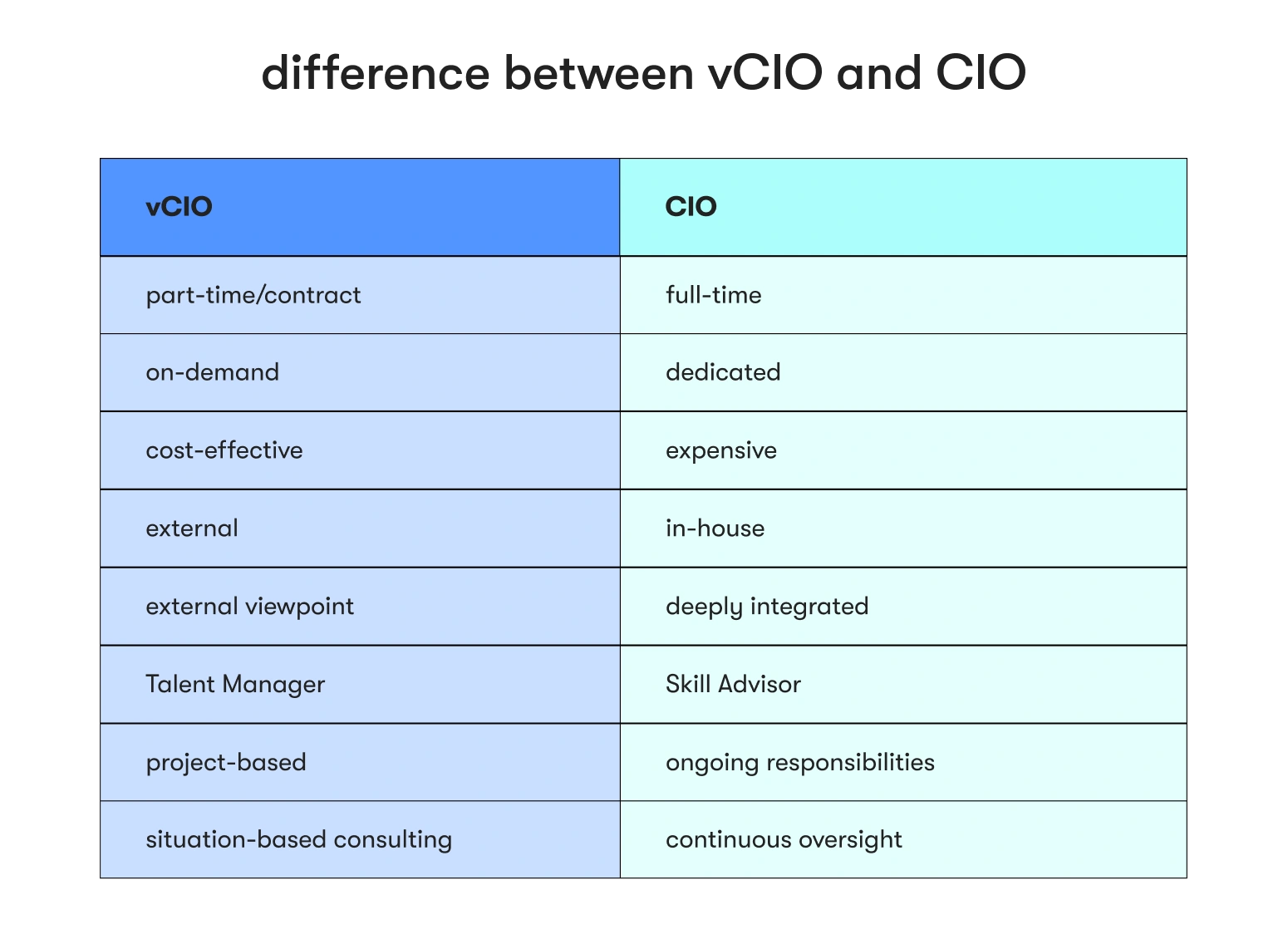In this era where digital transformation is not just a buzzword but a critical necessity, the role of strategic IT leadership cannot be overstated. Access to strategic IT leadership can be a game-changer for startups and small to medium-sized businesses.
Enter the virtual Chief Information Officer (vCIO) services. This transformative solution empowers organizations with the strategic expertise of a seasoned IT leader without the hefty price tag associated with a full-time executive.
In this comprehensive guide, we uncover the power and potential of vCIO services, shedding light on the nuanced intricacies that set them apart from traditional Chief Information Officers (CIOs). As we unravel the layers of this virtual paradigm, we aim to equip you with the knowledge to discern what a vCIO does and, more importantly, why your business urgently requires one.
What is a virtual CIO?
A virtual Chief Information Officer (vCIO) is a seasoned IT professional who provides strategic leadership and guidance to businesses remotely and flexibly. Unlike traditional Chief Information Officers, who typically hold full-time in-house positions within a company, vCIOs operate externally, offering their expertise and insights to organizations part-time or on a project basis.
The primary role of a vCIO is to align an organization's IT strategy with its overall business objectives. This involves understanding the company's goals, evaluating its existing technology infrastructure, and recommending and implementing solutions that enhance efficiency, security, and overall performance. Virtual CIOs leverage their extensive knowledge of information technology and industry best practices to ensure technology initiatives align with the company's long-term vision.
In addition to strategic planning, vCIOs often assist with technology budgeting, vendor management, risk assessment, and cybersecurity strategies. By working remotely, vCIOs offer businesses the opportunity to access high-level IT leadership without the financial commitment of hiring a full-time executive. This flexibility makes vCIO services particularly valuable for startups needing expert advice, small to medium-sized businesses, or any organization looking to optimize its IT strategy without the overhead costs of a dedicated C-level position.
GET A VCIO FOR YOUR PROJECT
Turn to our pool of virtual CIOs to consult and level up your business.
What makes vCIOs different from CIOs?
Traditional CIOs focus on in-house operations, overseeing IT strategies within the confines of a specific organization.
In contrast, vCIOs operate remotely, leveraging technology to provide strategic guidance without needing a physical presence. This flexibility allows businesses to tap into a vast pool of expertise tailored to their needs without the overhead costs associated with a full-time executive.
The differences between a virtual Chief Information Officer and a traditional Chief Information Officer extend beyond the physical presence of these roles. Here are the key distinctions:

Employment structure
- CIO: Typically holds a full-time in-house position within the organization.
- vCIO: Operates externally, providing services on a part-time, contract, or project-specific basis.
Flexibility
- CIO: Generally committed to the organization continuously, full-time.
- vCIO: Offers flexibility in time commitment, allowing businesses to access expertise as needed without a constant in-house presence.
Cost structure
- CIO: Involves a significant financial commitment, including a full-time salary, benefits, and other associated costs.
- vCIO: Often is a more cost-effective solution, as businesses can engage a vCIO on a contractual basis, paying for services rendered without the ongoing expenses of a full-time executive.
Scope of responsibility
- CIO: Manages the organization's IT strategy and infrastructure, often overseeing an in-house IT department.
- vCIO: Focuses on strategic IT leadership and guidance, collaborating with existing IT teams or external vendors to align technology initiatives with business objectives.
External perspective
- CIO: Deeply integrated into the organization's operations with an internal perspective.
- vCIO: Brings an external viewpoint, leveraging experience from various organizations and industries to provide fresh insights and best practices.
Project specificity
- CIO: Engages in various ongoing responsibilities, overseeing the entire IT landscape.
- vCIO: Often engaged for specific projects or strategic initiatives, allowing for a targeted focus on particular aspects of IT leadership.
Risk and compliance
- CIO: Is directly responsible for ensuring the organization complies with industry regulations and manages cybersecurity risks.
- vCIO: Collaborates with the organization to address risk and compliance but may have a different continuous oversight than an in-house CIO.
BOOST YOUR IT STRATEGY
Discover a full range of our vCIO consulting and engagement solutions.
What does a virtual CIO do?
Understanding the responsibilities of a vCIO is essential for businesses looking to optimize their IT strategy. vCIO services cover a range of critical areas to ensure comprehensive IT management.
Plan the technology roadmap
Crafting a customized technology roadmap is at the core of a vCIO's responsibilities. This involves aligning technology solutions with business goals, ensuring seamless integration, and planning for future scalability.
Create budgets
Developing comprehensive IT budgets is crucial for balancing innovation with cost efficiency. Our vCIOs work to maximize the value of IT investments, ensuring that every dollar spent contributes to the business's overall success.
Assess security measures
Conducting regular assessments of security measures to identify vulnerabilities and implement robust cybersecurity strategies.
Evaluate emerging technologies
Stay abreast of emerging technologies and assess their relevance to the business, ensuring technology investments align with future trends.
Vendor management
Effectively manage relationships with technology vendors to provide optimal service delivery and cost-effectiveness.
Why do you need a virtual CIO in your organization?
In an era where technology is the heartbeat of business operations, the role of a virtual Chief Information Officer transcends conventional IT support. Explore the tangible advantages that propel organizations forward, from fortifying cybersecurity consulting to optimizing IT infrastructure and navigating the complexities of the cloud. Uncover why a virtual CIO isn't just a strategic choice but a crucial investment in your business's resilience, security, and future-readiness in the dynamic digital landscape.

Improving IT infrastructure
A resilient and well-optimized IT infrastructure is the backbone of a successful business. Virtual CIO services prioritize enhancing your IT infrastructure, ensuring it meets current demands and is positioned for future growth. By leveraging the expertise of a vCIO, your business can stay ahead in the digital race, fostering an IT foundation that is robust, reliable, and scalable to adapt to emerging technological advancements.
Cybersecurity protection
With the persistent rise of cyber threats, safeguarding your business from potential hacking attempts has never been more critical. Virtual CIOs bring a wealth of cybersecurity knowledge, implementing proactive security measures to fortify your digital defenses. From assessing vulnerabilities to devising comprehensive cybersecurity strategies, a vCIO acts as a vigilant guardian, ensuring that your sensitive data remains secure in the face of evolving cyber threats.
Data backup and recovery
The unforeseen is an inevitable aspect of business, and preparation is key for critical data. Virtual CIO services include software development consulting and implementing robust data backup and recovery strategies. By safeguarding your essential data through regular backups, a vCIO minimizes downtime during unforeseen disasters or system failures, bolstering your business continuity and ensuring that crucial information remains accessible when needed.
Cloud expertise
Navigating the vast landscape of cloud computing can be complex, but with a vCIO, you gain access to a wealth of cloud expertise. Virtual CIOs guide businesses in harnessing the full potential of cloud solutions, tailoring strategies to enhance operational efficiency and scalability. Whether migrating to the cloud, optimizing the existing cloud infrastructure, or adopting innovative cloud-based technologies, a vCIO ensures that your business reaps the benefits of cloud computing while mitigating potential challenges.
In essence, having a virtual CIO on your team is not just a strategic advantage; it's a proactive approach to fortifying your business against the ever-evolving challenges of the digital landscape. From building a resilient IT infrastructure to safeguarding against cyber threats and harnessing the power of the cloud, a vCIO empowers your business with the expertise needed to thrive in the technology-driven world.
Cost optimization
A dedicated vCIO is instrumental in devising a strategic IT plan that aligns with your organizational goals, ensuring that technology investments align with your business objectives and are cost-effective. A vCIO helps your organization make informed decisions that maximize value while minimizing unnecessary expenses by providing insights into the most beneficial and budget-friendly technologies.
Effectively managing relationships with technology vendors is paramount to cost savings. A vCIO takes charge of vendor negotiations, contract reviews, and service optimizations, ensuring your organization secures the best value for its technologies and services. This meticulous approach to vendor management contributes to reducing overall technology expenses.
LOOKING FOR A VCIO TO JOIN YOUR PROJECT?
Boost productivity, improve strategies, and turn your vision into reality with our skilled vCIOs.
How much does a virtual CIO cost?
The cost of a virtual Chief Information Officer (vCIO) can vary widely based on several standalone factors and combinations, and it's essential to consider the following variables when budgeting for this service.
- Hourly rates: vCIOs may charge an hourly rate for their services. Rates can range from $100 to $300 per hour, depending on the vCIO's experience, expertise, and geographic location.
- Monthly retainer: Many vCIOs offer a monthly retainer fee, providing a set number of hours or specific services each month. Retainer fees can start from a few thousand dollars monthly.
- Project-based fees: For specific projects, vCIOs may charge a flat fee based on the scope and complexity of the project. This approach provides clarity on costs for well-defined initiatives.
- Annual contracts: Some businesses prefer to engage a vCIO on an annual contract, which may include a set number of hours per month or year. Annual contracts often come with a more favorable rate compared to shorter-term agreements.
- Size and complexity of the business: The scale and complexity of your business operations influence the cost. Larger organizations with intricate IT infrastructures may require more extensive services, impacting the overall cost.
- Industry expertise: If your business operates in an industry with specific compliance or regulatory requirements (such as healthcare or finance), vCIOs with expertise in those areas may command higher fees. The rates may also vary depending on the range of consulting the vCIO provides, like IT, business intelligence consulting, or other.
- Geographic location: Rates can vary based on the geographic location of the vCIO and your business. In regions with a higher cost of living, vCIO rates may be higher.
- Experience and reputation: Highly experienced vCIOs with a proven track record may charge higher rates. Their expertise can bring added value to your organization.
Final note
As we conclude our exploration of vCIO services, it's evident that strategic IT leadership is paramount in today's competitive business landscape. Our vCIO services significantly impact businesses, enabling them to optimize technology roadmaps, enhance cybersecurity, and reduce costs effectively.
Frequently asked questions

Anush has a history of planning and executing digital communications strategies with a focus on technology partnerships, tech buying advice for small companies, and remote team collaboration insights. At EPAM Startups & SMBs, Anush works closely with subject matter experts to share first-hand expertise on making software engineering collaboration a success for all parties involved.
Anush has a history of planning and executing digital communications strategies with a focus on technology partnerships, tech buying advice for small companies, and remote team collaboration insights. At EPAM Startups & SMBs, Anush works closely with subject matter experts to share first-hand expertise on making software engineering collaboration a success for all parties involved.
Explore our Editorial Policy to learn more about our standards for content creation.
read more


















